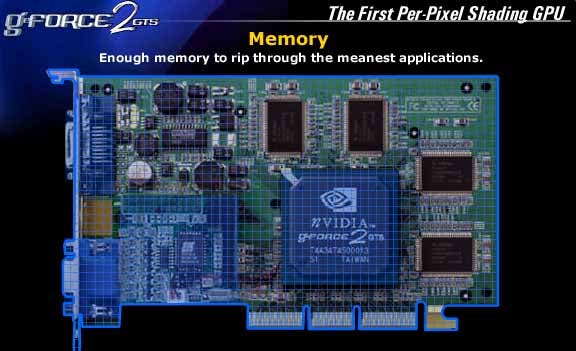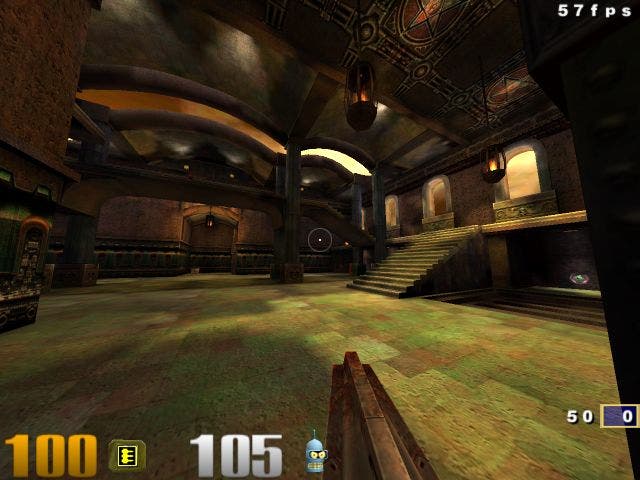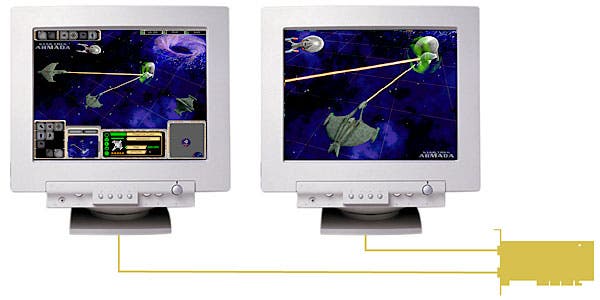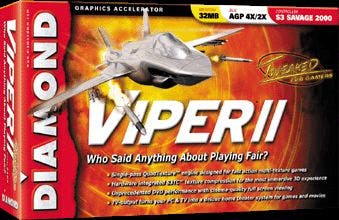Spring 2000 Graphics Card Round-Up
Next gen graphics cards compared
Spring has sprung, and with it has come a new generation of graphics cards from most of the major manufacturers. NVIDIA are shipping their GeForce 2, 3dfx are about to unleash the VSA-100, and ATI have announced their own effort, the Radeon 256.
Last week we took a look at graphics card jargon, explaining what all the buzz words and large numbers that these graphics companies quote actually mean. This week we take a look at the new generation of cards themselves...
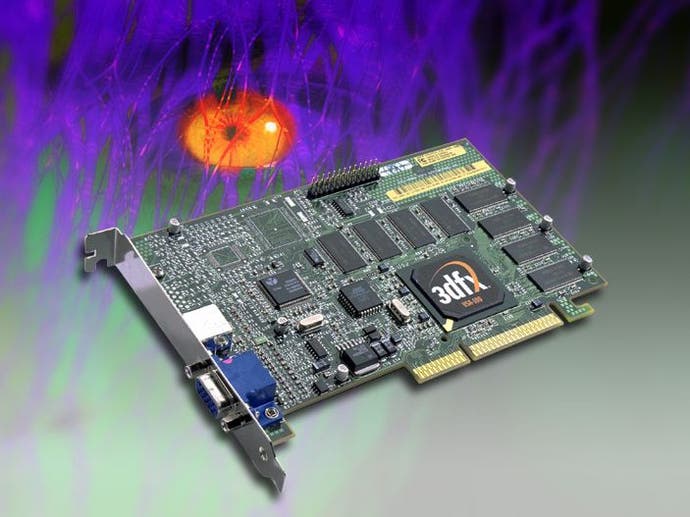
3dfx - Voodoo 4 4500 Price $179 / £150 Availability Late May Fill Rate 333 MegaPixels/second 333 MegaTexels/second Core Clock Rate 166MHz Memory 32Mb of 166MHz SDRAM T&L Acceleration No Anti-Aliasing 2x Spatial FSAA Texture Compression DXTC, FXT1 Bump-Mapping None? Advanced Features None?
3dfx's new VSA-100 chip is more than six months overdue, and most of its "new" features have now been standard in leading competitors' cards for a year or more. 32 bit colour and high resolution textures are all old news, and even DirectX texture compression support is common now.
3dfx's own FXT1 texture compression doesn't offer any real improvement over the now standard DXTC when it comes to performance or quality, although as FXT1 is cross-platform and open source it should allow for support on the Mac, Linux, and BeOS operating systems. Whether that will be enough to encourage developers to use it remains to be seen, and certainly no other hardware manufacturer is supporting it yet.
The VSA-100 does have one big new feature going for it though - the T-Buffer, which allows high quality full-scene anti-aliasing, as well as cinematic depth of field and motion blur effects.
FSAA should work automatically with any game running in Direct3D, OpenGL or Glide, but developers must add support for the other effects to their games themselves. Even 3dfx have been suspiciously quiet about the other T-Buffer effects recently, and it's obvious that they consider FSAA to be the killer feature of their new cards. Whether many developers will support the other effects is rather doubtful at this point.
Unfortunately the cheapest card in 3dfx's new range, the Voodoo 4 4500, uses just one VSA-100 chips, and so lacks the grunt to take advantage of the T-Buffer effects. In fact, until recently the Voodoo 4 4500 wasn't going to support any of the effects. 3dfx have now announced that it will support anti-aliasing after all, but only the lower quality 2x FSAA.
Even this will give a very noticeable improvement in visual quality, but the card's low fill rate means that it will also give a very noticeable performance hit in most modern games.
The Voodoo 4 4500 is effectively 3dfx's answer to the RivaTNT2 Ultra, which NVIDIA released a year ago. It won't be able to match the speed of the old SDRAM GeForce cards, let alone the new generation of graphics cards, but at £150 it is hardly a budget card.
It's hard to see who the Voodoo 4 4500 is aimed at. Its performance is too low for the hardcore gamer, its price too high for the budget user, and its features unremarkable by anyone's standards. Avoid like the plague.

3dfx - Voodoo 5 5000 / 5500 V5-5000 V5-5500 Price $229 / £200 $299 / £250 Availability Late May Fill Rate 667 MegaPixels/second 667 MegaTexels/second Core Clock Rate 166MHz Memory 32Mb of 166MHz SDRAM 64Mb of 166MHz SDRAM T&L Acceleration No Anti-Aliasing 4x Spatial FSAA Texture Compression DXTC, FXT1 Bump-Mapping None? Advanced Features T-Buffer effects
The next card up 3dfx's new range is the Voodoo 5 5000, which comes with two VSA-100 chips and 32Mb of memory. Unlike the Voodoo 4 4500, this card should have the fill rate necessary to make the most of 3dfx's new T-Buffer effects, but its Achilles heel is its memory.
Each VSA-100 chip needs its own copy of a game's textures in the card's memory, and so that 32Mb of memory is going to fill up much faster than in a normal graphics card. Effectively then the Voodoo 5 5000 is equivalent to a 20Mb single chip card, which is rather poor by today's standards. As a result the card's performance could suffer in games which use lots of high resolution textures.
3dfx's flagship product is the rather more expensive Voodoo 5 5500, which also features two VSA-100 chips but has a more ample 64Mb of memory. This is roughly equivalent to 36Mb on a single chip card, which compares very favourably with rival products.
The real world performance of the card is a little disappointing though, only out-pacing NVIDIA's six month old GeForce DDR at resolutions above 1024x768, and even then only by a fairly narrow margin. You certainly shouldn't be expecting to get anywhere near 3dfx's magic number of 60 frames per second in Quake 3 Arena at 1024x768 if you want to use high quality full-scene anti-aliasing.
You will still have to choose between image quality and raw frame rate, although at least this time 3dfx are giving you the choice. And like all the VSA-100 based cards, the Voodoo 5 5500 has no support for hardware T&L acceleration, something which is becoming more important as more and more games supporting the feature are released.
At around £200 the Voodoo 5 5500 is a very fast card at a fairly reasonable price, and the card's full-scene anti-aliasing should provide you with the best visual quality currently on the market. But without T&L acceleration you should expect to be buying another card by the end of the year.

3dfx - Voodoo 5 6000 Price $600 / £500 Availability Unknown Fill Rate 1333 MegaPixels/second 1333 MegaTexels/second Core Clock Rate 166MHz Memory 128Mb of 166MHz SDRAM T&L Acceleration No Anti-Aliasing 4x Spatial FSAA Texture Compression DXTC, FXT1 Bump-Mapping None? Advanced Features T-Buffer
The Voodoo 5 6000 is the new top of the range card from 3dfx, a triumph of sheer brute force which features four (!) VSA-100 chips working in unison and a massive 128Mb of RAM.
Of course, as with all the other cards in the Voodoo 5 range, most of that memory has to be shared between the multiple VSA-100 chips. Being able to brag to your friend that your graphics card has more memory on it than their entire computer might be worth something, but that 128Mb is in fact equivalent to more like 40Mb on a normal single chip card. Which is still plenty of memory, but nowhere near as impressive as the card's specs make it sound.
Something else which you can brag about to your mates if you buy one of these cards is the sheer size and power of it. The card needs a lot of real estate to accomodate four processors and eight 16Mb memory chips, and it needs a lot of juice to power them all. In fact, the Voodoo 5 6000 will come with a seperate external power supply! This is one insane card.
The real advantage of the Voodoo 5 6000 though is its fill rate - an earth shattering 1.33 GigaTexels! When 3dfx first announced the world's first GigaPixel graphics card last year it sounded too good to be true, but since then other companies have almost reached that level already. Still, the unique multi-processor design of the Voodoo 5 should allow this card to be faster than anything currently available at higher resolutions in most games.
Unfortunately that's the problem. The Voodoo 5 6000 isn't available yet, and won't be released at the same time as the other cards in 3dfx's new range. In fact, we aren't sure exactly when it will be released (July is the best bet at the moment), and we can only hope that history doesn't repeat itself...
Last year 3dfx's high spec card, the Voodoo 3 3500, was finally released almost four months after the rest of the Voodoo 3 range, and only a month before NVIDIA unveiled the GeForce. If it takes 3dfx another four months to release the Voodoo 5 6000, it is likely to be going up against a true next generation card from NVIDIA within weeks of its release.
At £400 the Voodoo 5 6000 is going to be the most expensive graphics card on the market aimed at gamers, and in all likelihood the fastest. But again, without support for hardware T&L acceleration, it is likely to become obsolete rather quickly.
ATI - Radeon 256 Price Unknown Availability Summer 2000 Fill Rate 400 MegaPixels/second 1200 MegaTexels/second Core Clock Rate 200MHz Memory Up to 128Mb of 400MHz DDR T&L Acceleration 30 Million Triangles/second 8 lights per triangle Anti-Aliasing Super-Sampling FSAA Texture Compression DXTC, S3TC Bump-Mapping Emboss, Dot3, EMBM Advanced Features Vertex Skinning (4-Matrix) Key Frame Interpolation 3D texture support
Despite having possibly the stupidest name of any of the new generation of graphics cards (wasn't Radeon a brand of washing powder?), ATI's latest offering should finally put them at the forefront of the graphics card industry.
The card has the fill rate and the features to go head to head with the latest that NVIDIA have to offer, as well as introducing some entirely new features such as Key Frame Interpolation, which we described in our big graphics jargon article last week.
It supports vertex skinning, with up to four matrices compared to the two supported by the GeForce, as well as transform & lighting support which promises to out-perform even the GeForce 2. It is the only graphics card to support all three forms of bump-mapping supported by Direct3D. And it's 3D texture support may provide benefit in future, as it can be used for more realistic real-time light and shadow effects.
ATI are already famous for their excellent video features, and the Radeon 256 builds on that with support for all 18 standard HDTV formats, as well as flat panel screens. And their new "adaptive de-interlacing" technology should help improve the visual quality when playing back DVD movies.
In the past ATI's cards have been under-performers. With the recent Rage Fury MAXX they were getting close to the leading bunch, but it looks like the Radeon 256 could be a real contender.
There are a few problems though... Firstly, ATI's drivers tend to be rather lacklustre, and that could prevent the card's true performance form being shown. Secondly, that release date of Summer 2000 is a little too vague for our taste, and there is still no word on how much the card will cost, and how much memory it will feature. If the card is delayed or costs too much, it could end up facing the Voodoo 5 6000 and NVIDIA's next generation of graphics cards later this year.
But here's something that should make you hot under the collar. The Radeon supports ATI's "MAXX" technology, which allows them to put two processors on to a single graphics card and (more or less) double the performance. If a single Radeon 256 chip can provide the level of performance that ATI are promising, imagine what two of them working in parallel could do! Drool.
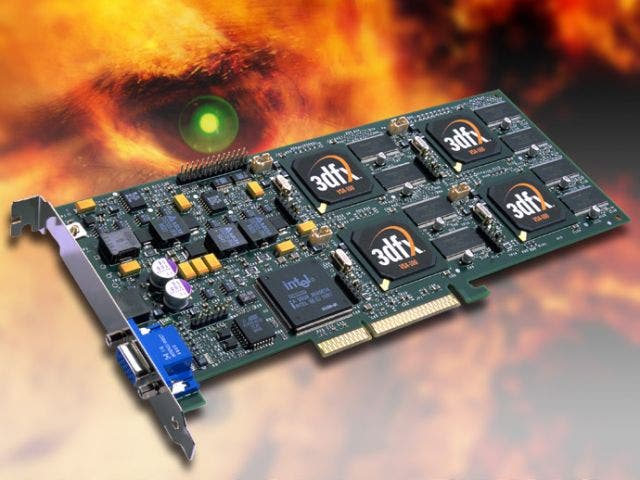
NVIDIA - GeForce 2 GTS Price $299-$349 / £200-250 Availability Already available Fill Rate 800 MegaPixels/second 1600 MegaTexels/second Core Clock Rate 200MHz Memory 32-128Mb of 333MHz DDR T&L Acceleration 25 Million Triangles/second 8 lights per triangle Anti-Aliasing Super-Sampling FSAA Texture Compression DXTC, S3TC Bump-Mapping Emboss, Dot3 Advanced Features Vertex Skinning (2-Matrix) NVIDIA Shading Rasterizer 3D texture support
NVIDIA might have been the undisputed heavyweight champions of the graphics card industry since the release of the original GeForce last autumn, but they haven't been resting on their laurels. Their new GeForce 2 GTS is already available, and is the first new generation graphics card to be released.
The card sees a massive increase in theoretical fill rate over the original GeForce cards, as well as improving T&L support. It also adds a big new feature in the shape of the "NVIDIA Shading Rasterizer", which allows up to seven seperate textures to be added to a scene in a single pass - the base textures, bump mapping, diffuse lighting, specular lighting, coloured fog, ambient lighting, and alpha transparency effects.
This should allow the gratuitous use of "per pixel" effects in games, adding extra detail to scenes without slowing things down. If you want to find out more about the NSR effects, read our recent GeForce 2 preview...
While 3dfx have been hyping full-scene anti-aliasing for the last six months, NVIDIA have actually got a product on the shelves which supports it.
As with ATI's Radeon, they are using a different method to achieve it though, which is technically inferior to 3dfx's FSAA support but still improves visual quality very noticeably. Unfortunately, just as with 3dfx's new cards, activating FSAA on the GeForce 2 or ATI's Radeon will use up a lot of your fill rate, and can cause a large performance hit in graphically intensive games like Quake 3 Arena.
The GeForce 2 also supports vertex skinning, although as we have already pointed out ATI's Radeon should provide better support for this feature, allowing for more realistic looking characters in future games. And as with the Radeon, the GeForce 2 supports flat panel screens and all 18 standard HDTV output formats. Which is nice.
The biggest problem with the GeForce 2 is that, as with the original, its real world performance is likely to be limited more by the available memory bandwidth rather than the fill rate - the processor is just sitting around waiting for data to arrive instead of working flat out all the time.
The GeForce 2's fill rate might be much greater than that of its predecessor, but the memory bandwidth has only increased by about 10% compared to a GeForce DDR card. The card's performance is being held back by its memory in many games, although it is still noticeably faster than the original GeForce cards, and can at least match the soon-to-be-released Voodoo 5 5500.
The biggest advantage of the GeForce 2 GTS though is that you will have a choice of cards to pick from. Whereas 3dfx are the only company to make 3dfx cards, and ATI the only company to make ATI cards, NVIDIA can rely on a dozen or more companies including Creative Labs, Guillemot and ELSA to produce cards based on its designs, giving you a choice of prices, software bundles, extra features, and memory configurations.
At the end of the day the GeForce 2 is the fastest card on the market, and at just over £200 the cheaper cards based on the design aren't going to be much more expensive than the Voodoo 5 5500, while offering a more future proof feature package.
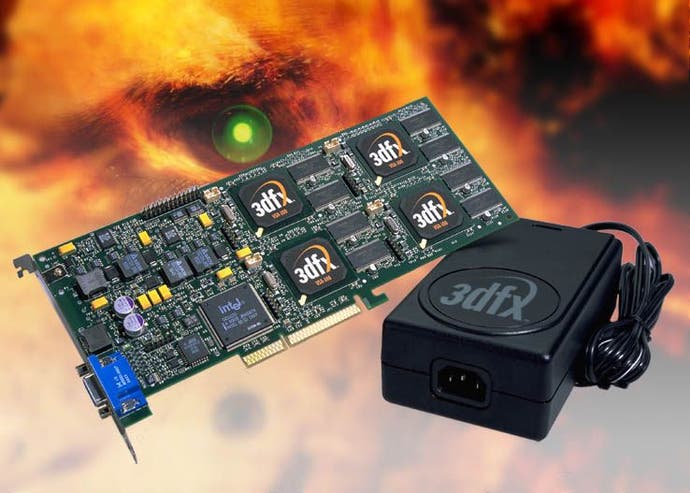
The Rest
Matrox have recently announced the G450, a follow-up to their excellent G400 graphics cards, which saw Matrox providing excellent 3D performance for the first time.
Due for release within the next couple of months, details of the G450 are still scant. We don't know how fast they will be, or how much they will cost, but what we do know is that they will not add support for modern features such as anti-aliasing and transform & lighting acceleration.
The new cards will improve the G400 MAX's "Dual Head" technology though, which allows you to use two monitors (or a monitor and a TV output) at once without needing to buy a second graphics card. It's a neat feature, but not enough on its own to make the cards worth buying.
Unfortunately the G450 is unlikely to shine next to the latest cards from their competitors, and they seem to be aimed more at the business market than at hardcore gamers, although there is still a steady trickle of games being released that support Dual Head.
Another company which looked like a real contender last year was S3. Their Virge graphics cards were infamous with gamers everywhere, more of a 3D decelerator than an accelerator.
But with the S3 Savage graphics card they seemed to be catching up with the bunch. It was still a little behind on raw performance, but was the first consumer graphics card to support texture compression, and its S3TC system is now industry standard and included in DirectX as DXTC.
Their follow-up, the Savage 2000, promised to out-perform the GeForce, but the reality was rather disappointing. T&L acceleration wasn't even active out of the box, and the monstrous fill-rate claimed by the card failed to deliver real world performance. S3 has now been bought out by motherboard manufacturer VIA, and there are no new S3 graphics cards in the pipeline. If you are on an extreme budget the Savage 2000 might be just what you are looking for, but otherwise S3 have little to offer gamers.
And of course there is always BitBoys Oy, and their fabled Glaze3D design. This small Finnish company is rapidly becoming a joke, as they have been promising to unleash a revolutionary new graphics card design on the world for the last year or two, but still haven't actually produced anything as far as we can tell.
If they actually release anything in the next few months I will personally eat one of their graphics cards at the big ECTS trade show in London. I am confident that I won't be dining on silicon this September...
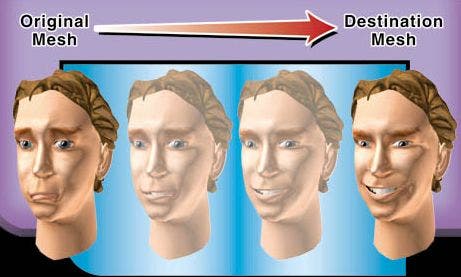
The Future
Well, that's all the main players as they stand today. Of course, the graphics card market moves fast even by the standards of the computer hardware industry, and you can always bet that whatever card you buy today, there will be a faster one coming along in six months time.
NVIDIA are currently on schedule to produce their true next generation card, code-named the NV20, by the end of the year, and its performance should blow away all of the current cards comfortably.
Meanwhile 3dfx are still working on their next generation "Rampage" chip as far as we know, which will be their first card to support T&L acceleration, as well as providing the ridiculously high fill rates we have come to expect from 3dfx, along with their new T-Buffer effects.
The "Rampage" was originally planned to be available by the end of this year, but the delays that have crippled the VSA-100 range of cards may have a knock-on effect on their progress with Rampage. 3dfx have also recently acquired another company called GigaPixel, and are working on implementing their technology into another generation of chips beyond that.
Certainly it's safe to say that for the hardcore gamer the future is going to be exciting, but expensive...

Decision Time
So, now for the big $300 question. Which card is right for you? Well, we're going to have to cop out here and say "that depends"... What are you going to use it for? How much money do you have to spend on a new graphics card? And what do you have in your computer already?
The Voodoo 4 4500 is really aimed at the OEM market, and is poor value for money, while the Voodoo 5 5000 lacks memory, which makes it a poor choice for serious gamers as well. You are probably best leaving these cards alone, unless of course you are only going to be using them to play QuakeWorld (freak!).
The Voodoo 5 5500 is 3dfx's new flagship product, and the one worth looking at seriously. It is on a par with the fastest card on the market, and also offers excellent image quality, particularly when full-scene anti-aliasing is used. On the downside it doesn't support T&L acceleration, and you will need a very fast CPU to make the most of it.
If you have an older 3dfx card or a RivaTNT based card and are looking for a reasonably priced replacement, the Voodoo 5 5500 could be what you want. It is particularly well suited for fans of flight sims, driving games, and 3D adventure and role-playing games, as these will show the most noticeable improvement in visual quality when FSAA is activated, but shouldn't suffer such a big performance hit when using it.
The Voodoo 5 6000, if and when it is released, is way too expensive for what it offers. If you are a hardcore user who really feels the need for speed, and you don't mind seeing your card getting out-performed by a much cheaper model a few months down the line, go ahead and buy this. Otherwise leave it well alone!
ATI's Radeon 256 might not appear for another few months, we don't know how much it will cost, and there is always the chance that its real performance won't be quite as impressive as it looks on paper. But if you already have a GeForce graphics card and don't mind waiting, it should be worth hanging on to find out more. The Radeon 256 should also offer the best DVD playback seen on a PC to date, so movie fanatics like myself should love this card.
The GeForce 2 GTS is probably the star of the graphics card industry at the moment though, offering the best raw performance on the market along with great features that should provide it with a long shelf-life. If, like me, you are long overdue an upgrade, then the GeForce 2 is probably as good as they come at the moment, particularly if you plan to hold on to your graphics card for another year or more before upgrading again.
If you already have a GeForce DDR card, then you are probably best holding off for a few more months though. The GeForce 2 doesn't offer that much of a performance increase for your £200, and NVIDIA will have a much faster card out in time for Christmas.
Of course, the rapid pace of change in the graphics industry does mean that cards which were state of the art six months ago are now becoming available at greatly reduced prices. The GeForce DDR isn't much slower than the new generation of graphics cards, and is already cheaper than most of them, with more price cuts likely to come soon. With support for T&L and now FSAA with the latest drivers, the GeForce DDR is a very good choice if you can't afford a Voodoo 5 5500 or GeForce 2 but can't hold off upgrading any longer.
And if you are on a real budget, you can pick up a RivaTNT2 based card for under £100, and a Savage 4 for as little as £50! They might not be state of the art, but if (like me) you have a very old graphics card they should at least tide you over until the next generation of cards start to arrive this Christmas.
So there you have it...
-
Noddy's Guide To Graphics Card Jargon
Creative Labs Annihilator Pro review
